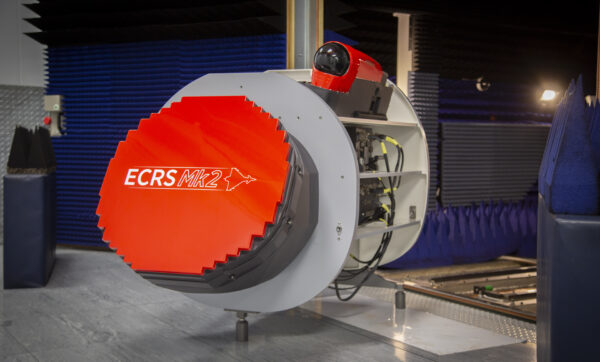
By Richard Scott
BAE Systems has completed a first flight of a Typhoon combat aircraft equipped with a prototype European Common Radar System Mk 2 (ECRS Mk 2) multifunctional radar.
Developed by Leonardo UK, the new wideband active electronically scanned array (AESA) radar embodies advanced electronic warfare (EW) capabilities, including high-power electronic attack (EA), alongside traditional radar functions. Forming the centerpiece of the wider Phase 4E upgrade package, ECRS Mk 2 is currently planned for retrofit to all 40 Tranche 3 Typhoons in Royal Air Force (RAF) service, with initial operating capability currently scheduled for 2030.
According to BAE Systems, the first flight of Typhoon test and evaluation aircraft ZK355/BS116 with the prototype ECRS Mk 2 was completed from BAE Systems’ Warton aerodrome in northwest England on September 27. This initial shakedown sortie, as the precursor to more intensive testing commencing in the latter part of 2024, follows on from a campaign of land-based test and evaluation in the Integrated Test Facility (ITF) on the Warton site. Test, integration and development in ITF test rigs has been designed to de-risk integration and thus significantly reduce number of actual flight hours required.
ECRS Mk 2 has been developed to meet the RAF’s requirements for a multifunctional radar system which, alongside traditional radar functions, will support EW through a capability to locate, identify and suppress enemy air defenses (SEAD). In the last instance, this means generating high-power wideband EA effects within a contested and congested electromagnetic environment.
To achieve these goals, ECRS Mk 2 features a new high-power multifunction array which, according to Leonardo, hosts a significantly greater number of Transmit/Receive Modules (TRMs) in the array face than comparable AESA radars. The combination of large array and wider bandwidth will offer the pilot the ability to simultaneously task the radar to perform air-to-air, air-to-surface, EW, and EA functions.
Although the number of TRMs on the multifunction array face has not been disclosed, Leonardo has revealed that ECRS Mk 2 makes use of both GaAs and GaN semi-conductors within its AESA. The array itself is mounted on a wide-field-of-regard repositioner, using a circular rotating drive on the forward bulkhead. This increases scan volume, allows for variable polarization, and optimizes maximum power on target across the field of regard.
The ECRS Mk 2 prototype combines the multifunction array from the previous “Bright Adder” technology demonstrator program with the back end from the existing Captor-E/ECRS Mk 0 radar. However, the production-standard radar will introduce a new multichannel receiver, high-capacity multichannel processor, and antenna power supply and control unit to fully realize the performance of the new multifunction array and EW capability.
Alongside the multichannel receiver, ECRS Mk 2 also integrates a dedicated EW receiver and an EA techniques generator developed by Leonardo’s EW business in Luton. The EW and EA/SEAD functionality within ECRS Mk 2 will be fully integrated into the platform’s Praetorian Defensive Aids Sub System under BAE System’s leadership as the avionics suite integrator.
Another important aspect of the ECRS Mk 2 design is the adoption of an open architecture back end. This is intended to enable software-based technology insertions to be implemented in short timescales and at lower cost.
ECRS Mk 2 exploits research and development previously pursued under the UK’s earlier Advanced Radar Targeting System and Bright Adder radar testbeds. ARTS began flight trials in 2007, with sorties performed in both the UK and the US. The follow-on Bright Adder technology demonstrator program, beginning in 2010, sought to demonstrate the integration of high-power EA techniques into the radar system.
One consequence of the expanded operating bandwidth afforded by ECRS Mk 2 multifunction array is the need to develop a new wide bandwidth nose radome for Typhoon. Meggitt has worked with BAE Systems and Leonardo to design and develop a technical solution which, while maintaining the exact aerodynamic profile of the existing Typhoon radome, uses a different composite materiel composition to optimize transmissivity across the frequency band.



